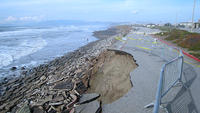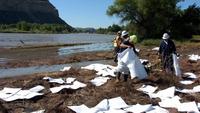-
Placement of wind-turbine increases power tenfold

The power output of wind farms can be increased by an order of magnitude — at least tenfold — simply by optimizing the placement of turbines on a given plot of land; rather than build taller towers and bigger blades, efficient wind-based energy production should focus on the design of the wind farm itself, to maximize its energy-collecting efficiency at heights closer to the ground
-
-
Melting ice sheets chief cause of rising sea levels
There are two causes for rising sea levels — melting ice sheets and thermal expansion of warming ocean waters; during the Last Interglacial Period, the former contributed much more to rising sea levels than the latter, a University of Arizona-led team of researchers has found; the results further suggest that ocean levels continue to rise long after warming of the atmosphere levels off
-
-
U.S. West Coast is rapidly eroding, with pace to accelerate

The stormy conditions of the 2009-10 El Nino winter eroded beaches from San Diego to Seattle to often unprecedented levels; the higher sea levels expected due to global warming, and potentially even stronger winter storms, will likely to contribute to increased rates of beach and bluff erosion along much of the U.S. West Coast
-
-
Understanding deadly tornadoes

Scientists at the University of Alabama in Huntsville (UAH) are analyzing radar data from 27 April 2011 — the day that saw of the deadliest tornado outbreaks in U.S. history — then merging the information with detailed storm surveys and other data; they hope to learn more about how the storms formed, what made the storms so powerful and what might be done to make tornado warnings more effective
-
-
Creating genetic replacement for oil
Scientists previously established that oil and coal have their roots in the organisms that lived on the planet over 500 million years ago, but researchers only are sure of one organism that directly contributed to these natural resources — that organism is the algae Botryococcus braunii; this algae is very slow growing, so it is not necessarily a good source for biofuels; scientists offer an alternative
-
-
World's first cardboard vacuum cleaner unveiled

A U.K. vacuum cleaner manufacturer will market a high performance vacuum cleaner constructed out of recycled and recyclable materials; the device was designed by an industrial design student; the corrugated cardboard panels that form the body of the machine are easily replaced if damaged and cost just a tenth of the price of an equivalent plastic panel
-
-
Montana floods exacerbate Exxon oil spill

Flooding in Montana has exacerbated the effects of an oil spill and made clean up more difficult for Exxon Mobil; it is estimated that roughly 750 top 1,000 barrels of crude oil have leaked into the Yellowstone River near Billings, Montana; the pipeline has been shut down, but flooding in the area has made it difficult for clean-up crews to find the source of the leak
-
-
Japanese discovery could undermine China's rare earth dominance
A new discovery by Japanese researchers could break China’s stranglehold over rare Earth metals; Japanese geologists say they have found large deposits of rare Earth minerals on the floor of the Pacific Ocean; it is estimated that the mud of the Pacific Ocean contains 100 billion tons of these minerals
-
-
Microalgae : Texas' next big cash crop
There are an estimated 200,000 to 800,000 species of microalgae — microscopic algae that thrive in freshwater and marine systems; scientists say microalgae offers a huge, untapped source of fuel, food, feed, pharmaceuticals, and even pollution-busters; it is set to be Texas’ next big cash crop
-
-
Flights increase rain and snow near airports
Areas near commercial airports experience a measurable increase in rain and snow when aircraft take off and land under certain atmospheric conditions; when planes fly through certain mid-level clouds, they force nearby air rapidly to expand and cool; this causes water droplets to freeze to ice and then turn to snow as they fall toward the ground, often leaving behind odd-shaped gaps in the clouds
-
-
Farm animal disease to increase with climate change
Researchers looked at changes in the behavior of bluetongue — a viral disease of cattle and sheep — from the 1960s to the present day, as well as what could happen to the transmission of the virus forty years into the future; they found, for the first time, that an outbreak of a disease could be explained by changes to the climate
-
-
Disappearing La Niña blamed for U.S. disastrous weather since January
La Niña and El Niño are opposite extremes of a great Pacific oscillation; every two to seven years, surface waters across the equatorial Pacific warm up (El Niño) and then they cool down again (La Niña); each condition has its own distinct effects on weather; La Niña was strong in December, but disappeared in January, leaving nothing to constrain the jet stream; the jet stream took advantage of the new freedom — with disastrous results for the weather
-
-
Official dispels government green procurement regulation myths

The U.S. government owns or manages one in five acres in the United States, and is the largest domestic user of electricity; it is also one of the largest consumers of resources in the United States, purchasing on average $535 billion worth of goods each year; In 2009 President Obama issued an executive order requiring that all government agencies establish and implement plans to increase their environmental performance; speaking at the 2011 Security Industry Association’s (SIA) Government Summit to an audience of security professionals, a government official sought to clarify myths surrounding the government’s new green procurement regulations and assured government service providers that the rules would not drastically affect a company’s existing practices
-
-
China deploys drought relief team to country's north
China’s northernmost provinces are still suffering from a prolonged drought that has been the country’s worst in fifty years; in the northern provinces and the autonomous regions of inner Mongolia more than 11.67 million people and 3.62 million livestock have been affected by the drought; nearly six million acres of the region’s crops have also been hit hard by the drought; the government has declared it a level-four emergency, the highest level, and is launching a full out emergency response plan to aid the beleaguered region
-
-
Record rise in sea level in two millennia
An international research team of scientists has shown that the rate of sea-level rise along the U.S. Atlantic coast is greater now than at any time in the past 2,000 years and that there is a consistent link between changes in global mean surface temperature and sea level
-
- All
- Regional
- Water
- Biometrics
- Borders/Immig
- Business
- Cybersecurity
- Detection
- Disasters
- Government
- Infrastructure
- International
- Public health
- Public Safety
- Communication interoperabillity
- Emergency services
- Emergency medical services
- Fire
- First response
- IEDs
- Law Enforcement
- Law Enforcement Technology
- Military technology
- Nonlethal weapons
- Nuclear weapons
- Personal protection equipment
- Police
- Notification /alert systems
- Situational awareness
- Weapons systems
- Sci-Tech
- Sector Reports
- Surveillance
- Transportation
Advertising & Marketing: advertise@newswirepubs.com
Editorial: editor@newswirepubs.com
General: info@newswirepubs.com
2010-2011 © News Wire Publications, LLC News Wire Publications, LLC
220 Old Country Road | Suite 200 | Mineola | New York | 11501
Permissions and Policies
Editorial: editor@newswirepubs.com
General: info@newswirepubs.com
2010-2011 © News Wire Publications, LLC News Wire Publications, LLC
220 Old Country Road | Suite 200 | Mineola | New York | 11501
Permissions and Policies
